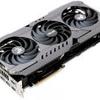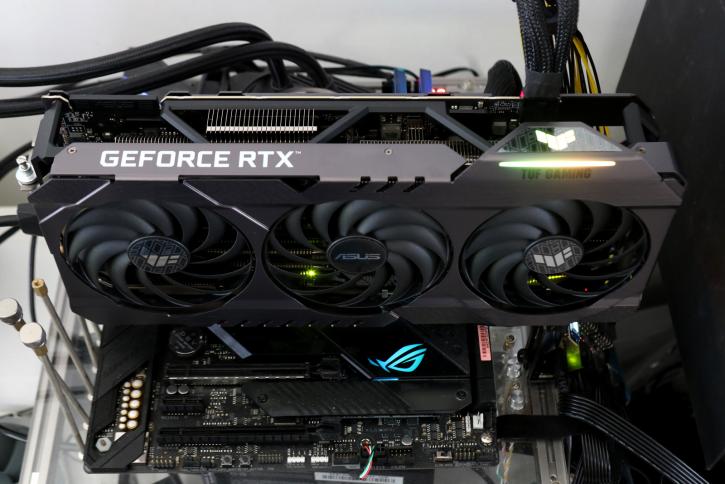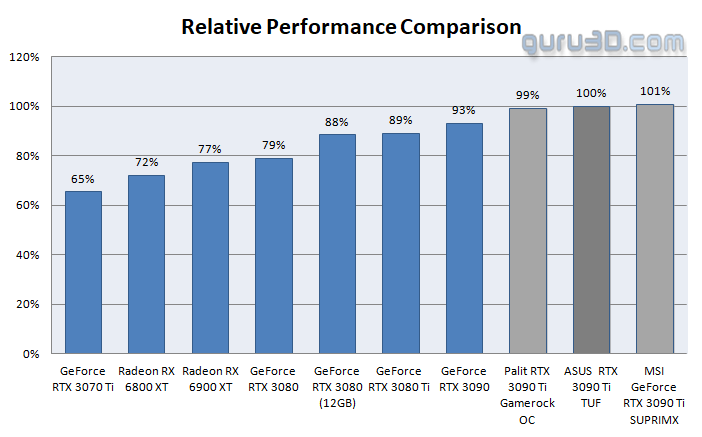Final words and conclusion
Performance
The ASUS TUF Gaming GeForce RTX 3090 Ti is a high-performing graphics card based on the RTX 3090 Ti GPU from Nvidia. It is capable of running any game at ultra-high resolution and with ray-tracing enabled. It should have no problem running games at more than 60 frames per second at 4K resolution, especially with DLSS in mind. However, it's a product maybe 7-8% faster than a reference 3090 whilst consuming roughly 100 Watts more energy at a starting price of 2000 USD. You must feed the card what it requires, preferably a GPU-intensive game in Ultra HD. NVIDIA says that this card is capable of running games at 8K resolution; however, we cannot verify this objectively. At Full HD, you'll frequently encounter bottlenecks and CPU constraints. However, the performance boost in some games with good programming and the appropriate API (DX12/ASYNC computation) is amazing. The venerable rasterizer engine smashes straight over the extreme performance barrier. All of this is possible because to the 10+ K Shading processors. We can confidently declare that this is a real Ultra HD capable graphics card, as it should be at this price point. However, whether you use regular rendering or games that support ray tracing and DLSS management all come together in that UHD resolution. An updated generation (more powerful) Ray tracing and Tensor cores have been added to the RTX 30 series. Therefore, do not be misled by the real RT and Tensor core counts. They're positioned close to the rendering engine, which means they've become more efficient, which shows. When using an RTX 2080 with Port Royale, we can get over 30 frames per second. Almost 70 frames per second, the RTX 3090 Ti greatly doubles that. Tensor cores are more difficult to quantify, but given what we have observed thus far, everything appears to be in balance. Overall, the GeForce RTX 3080 makes sense starting at a Quad HD resolution (2560x1440), whereas the RTX 3090 and Ti make sense starting at an Ultra HD resolution (3840x2160). As is typically the case when comparing apples to oranges, performance statistics differ slightly between architectures due to each architecture's inherent benefits and weaknesses in certain game render workloads.
Cooling & noise levels
The TUF series supports two distinct BIOSes. By default, Q mode is selected. And at 38~39 DBa, the card offers really balanced acoustics. Remember this product has a 460 Watt TGP, and that requires serious real-estate cooling wise. The trade-off is that temperatures in this mode are closer to 75 degrees C. Although this is not an issue for the card, we know and realize that end users will always have peace of mind if the card operates at or below 80 degrees Celsius. Alternately, you can use the Performance BIOS setting. Here performance drops at 65-70 Degrees C depending on your chassis airflow, which is terrific; however, your acoustic noise level will rise significantly, and the noise level was too much for my taste. Q modus however is fine.
Energy
NVIDIA is listing a TGP at 350 Watt for the 3090 FE. This 3090 Ti factory tweaked one has a ~450 Watt TGP. Our measured total board power passes that 450 Watts when looking at peaks. Add to that any tweaks you might apply, and you're closing in at 500 Watts. Regardless of how I look at it, I am not comfortable with this kind of power usage in this day and age with rising KWh prices throughout Europe.
Coil whine
Where the FE produces some, we had a hard time detecting coil whine on this card. Graphics cards all make this in some form, especially in high framerates this can be perceived. In a closed chassis, that noise fades away in the background.
Pricing
NVIDIA is pricing the GeForce RTX 3090 Ti at $1999 USD. It's excessive money for something to play PC games on. This product is so exclusive that it creates its own niche. This AIB card will likely get listed at €2200 with a similar number in USD. But if availability is low, we can easily see the prices hike to the sub-2500 EUR/USD marker.
Tweaking
We've been mildly conservative with tweaking this card, and so should you. Remember you're already at a power budget close to 500 Watts. Our card has a restricted power limiter, e.g. you cannot increase power usage. Also, voltage regulation was not in place just yet. In the end, a +125 Mhz on the core offset brought the card towards 2200 MHz depending on the game. However, due to the power limiter, you'll be more restricted. The memory easily could take another +750 Mhz. And at double data rate that made it work perfectly fine at 22500 MHz (effective data-rate). Overall we've been able to bump roughly 4-5% additional performance out of the card.
Conclusion
While the TUF Gaming RTX 3090 Ti is undoubtedly an animal in terms of gaming performance, unless you're using it for rendering or sumptuous 4K/8K gaming, the additional 24GB of VRAM will almost certainly go unused. Unless you're going all-in on your setup, the RTX 3080 Ti or RTX 3070 Ti is still the choice to make — at the least, you'll have a far better chance of actually utilizing that 12GB or 10GB of VRAM.
The 3090 Ti TUF Gaming increased performance by close to 7~8% compared to the 3090 founder edition. And it's clocked faster than the new Ti founder edition. It's a stunning product—both in terms of gaming performance and rendering quality. My primary considerations are not performance, cooling. This card uses close to 500 Watts of power, which is just too too much in the year 2022, that and the price level obviously. Likely many of you will disagree with me or will be unconcerned about energy use though. For this card to make any sense, you must be gaming in an Ultra HD resolution or above. Regardless of my frowning on price and energy consumption; I do adore a nice chunk of gear inside a PC, though. Please ensure that you have enough ventilation, as the RTX 3090 Ti generates a great deal of heat. Although it is large, it still looks fantastic. Remember this though, the card is extremely powerful if you provide it with the proper circumstances, these are the highest resolutions, image quality settings, and GPU bound games. Performance-wise inbetween brands really, you trade perhaps 1% or 2% here and there. So that is not the decisive factor to beat. Tweaking-wise, this card series will offer another ~5% performance (depending on your luck). In the end, this GeForce RTX 3090 Ti with 10,752 CUDA cores is quicker in 4K than the GeForce RTX 3090 with 10,496 compute units. Whether or not that is worth the extra 100 Watts and 2000 USD price tag is a hard call to make really. Especially with Hopper architecture now on the horizon. Asus does a good job of designing cooling systems capable of taming the 450W-500W GPUs without generating excessive noise and maintaining stable temperatures. For RTX GPUs, the primary issue is mostly out of Asus' hands, availability, and street prices. With that stated and having in mind that this card will cost twice as much as the RTX 3080 Ti with similar cooling, we'd recommend the latter to 99 percent of enthusiasts. For the remaining single digit %, the Asus GeForce RTX 3090 Ti TUF Gaming OC could unquestionably be on your no-compromise shortlist.
Sign up to receive a notification when we publish a new article.
Or go back to Guru3D's front page
- Hilbert, LOAD"*",8,1.



